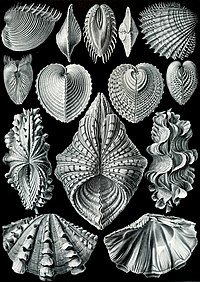
Changes in biogeographic distribution patterns of southern mid-to high latitude planktonic foraminifera during the Late Cretaceous hot to cool greenhouse climate transition
Sign Up to like & getrecommendations! Published in 2020 at "Cretaceous Research"
DOI: 10.1016/j.cretres.2020.104547
Abstract: Abstract The biogeographic distribution of planktonic foraminifera from southern mid-to high latitudes region are discussed to identify links between species distribution patterns and the changes in Late Cretaceous climate. We present relative abundance data for… read more here.
Keywords: southern mid; climate; mid high; distribution ... See more keywords

New observations of planktonic foraminifera from the Burdigalian-Langhian deposits (Kilisecik Formation) of Kahramanmaraş/Turkey
Sign Up to like & getrecommendations! Published in 2017 at "Journal of African Earth Sciences"
DOI: 10.1016/j.jafrearsci.2017.07.010
Abstract: Abstract Early-Middle Miocene is a period of significant geological events (such as global marine transgression) on the Alpine-Himalayan belt. The Kahramanmaras Basin is located in transition between the Taurides and Arabian Plate, which are important… read more here.
Keywords: new observations; kilisecik formation; burdigalian langhian; planktonic foraminifera ... See more keywords

Paleocene planktonic foraminifera from DSDP Site 356, South Atlantic: Paleoceanographic inferences
Sign Up to like & getrecommendations! Published in 2017 at "Marine Micropaleontology"
DOI: 10.1016/j.marmicro.2017.07.001
Abstract: Abstract In the present study, the planktonic foraminiferal distribution in a core section representing an interval between the Cretaceous/Paleogene (K/Pg) boundary and the end of the Paleocene (Danian/Selandian) from DSDP Site 356 (Sao Paulo Plateau,… read more here.
Keywords: foraminifera; water column; dsdp site; planktonic foraminifera ... See more keywords

Radiocarbon Age Offsets Between Two Surface Dwelling Planktonic Foraminifera Species During Abrupt Climate Events in the SW Iberian Margin
Sign Up to like & getrecommendations! Published in 2019 at "Paleoceanography and Paleoclimatology"
DOI: 10.1029/2018pa003490
Abstract: This study identifies temporal biases in the radiocarbon ages of the planktonic foraminifera species Globigerina bulloides and Globigerinoides ruber (white) in a sediment core from the SW Iberian margin (so‐called Shackleton site). Leaching of the… read more here.
Keywords: iberian margin; radiocarbon; 14c ages; foraminifera species ... See more keywords

Sea Surface Temperatures and Paleoenvironmental Variability in the Central Mediterranean During Historical Times Reconstructed Using Planktonic Foraminifera
Sign Up to like & getrecommendations! Published in 2019 at "Paleoceanography and Paleoclimatology"
DOI: 10.1029/2018pa003529
Abstract: The ongoing anthropogenic‐induced warming assessment requires a robust background from regional sea surface temperature (SST) reconstructions. Planktonic foraminifera have yielded valuable insights into late Quaternary SST dynamics, but the techniques to estimate SST from fossil… read more here.
Keywords: central mediterranean; sea surface; variability; planktonic foraminifera ... See more keywords

Endless Forams: >34,000 Modern Planktonic Foraminiferal Images for Taxonomic Training and Automated Species Recognition Using Convolutional Neural Networks
Sign Up to like & getrecommendations! Published in 2019 at "Paleoceanography and Paleoclimatology"
DOI: 10.1029/2019pa003612
Abstract: Planktonic foraminiferal species identification is central to many paleoceanographic studies, from selecting species for geochemical research to elucidating the biotic dynamics of microfossil communities relevant to physical oceanographic processes and interconnected phenomena such as climate… read more here.
Keywords: modern planktonic; training; taxonomic training; planktonic foraminiferal ... See more keywords

A Sediment Trap Evaluation of B/Ca as a Carbonate System Proxy in Asymbiotic and Nondinoflagellate Hosting Planktonic Foraminifera
Sign Up to like & getrecommendations! Published in 2020 at "Paleoceanography and Paleoclimatology"
DOI: 10.1029/2019pa003682
Abstract: The ratio of boron to calcium (B/Ca) in a subset of foraminifera has been shown to covary with seawater carbonate chemistry, making this geochemical signature a promising proxy for carbon cycle science. Some studies suggest… read more here.
Keywords: sediment trap; foraminifera; planktonic foraminifera; carbonate ... See more keywords

Sixty-one thousand recent planktonic foraminifera from the Atlantic Ocean
Sign Up to like & getrecommendations! Published in 2018 at "Scientific Data"
DOI: 10.1038/sdata.2018.109
Abstract: Marine microfossils record the environmental, ecological, and evolutionary dynamics of past oceans in temporally expanded sedimentary archives. Rapid imaging approaches provide a means of exploiting the primary advantage of this archive, the vast number of… read more here.
Keywords: sixty one; atlantic ocean; planktonic foraminifera; foraminifera ... See more keywords

Exploring the impact of climate change on the global distribution of non-spinose planktonic foraminifera using a trait-based ecosystem model.
Sign Up to like & getrecommendations! Published in 2021 at "Global change biology"
DOI: 10.1111/gcb.15964
Abstract: Planktonic foraminifera are one of the primary calcifiers in the modern ocean, contributing 23-56% of total global pelagic carbonate production. However, a mechanistic understanding of how physiology and environmental conditions control their abundance and distribution… read more here.
Keywords: foraminifera; non spinose; model; climate change ... See more keywords

Controls on planktonic foraminifera apparent calcification depths for the northern equatorial Indian Ocean
Sign Up to like & getrecommendations! Published in 2019 at "PLoS ONE"
DOI: 10.1371/journal.pone.0222299
Abstract: Within the world’s oceans, regionally distinct ecological niches develop due to differences in water temperature, nutrients, food availability, predation and light intensity. This results in differences in the vertical dispersion of planktonic foraminifera on the… read more here.
Keywords: equatorial indian; indian ocean; apparent calcification; foraminifera ... See more keywords

An extinction event in planktonic Foraminifera preceded by stabilizing selection
Sign Up to like & getrecommendations! Published in 2019 at "PLoS ONE"
DOI: 10.1371/journal.pone.0223490
Abstract: Unless they adapt, populations facing persistent stress are threatened by extinction. Theoretically, populations facing stress can react by either disruption (increasing trait variation and potentially generating new traits) or stabilization (decreasing trait variation). In the… read more here.
Keywords: stabilization; populations facing; extinction; stress ... See more keywords